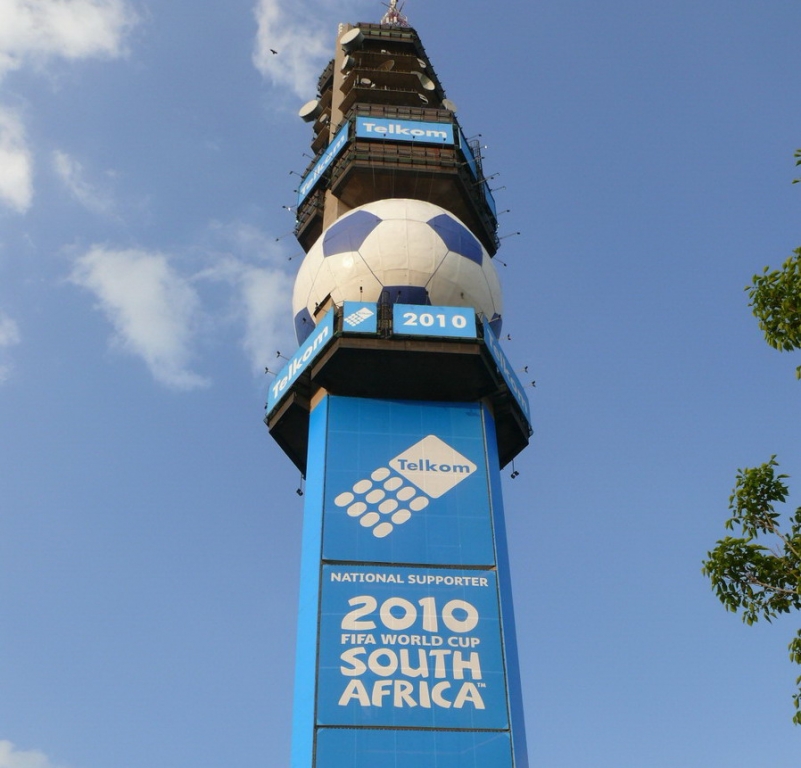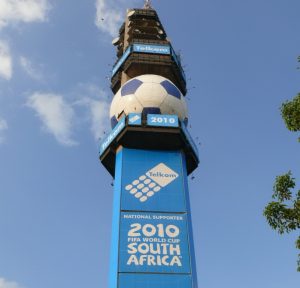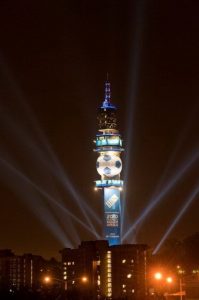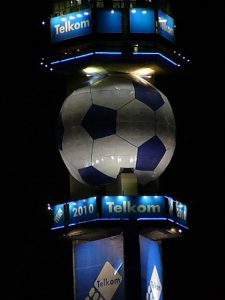When South Africa was named the host of the FIFA 2010 Soccer World Cup, the first time an African nation will host the tournament, a sponsor wanted to make a big statement. Its superlative branding can now be seen for miles — and also in the record books.
Telkom, the sponsor, was identifying buildings and structures to use for branding purposes. However, Graphic Wizard, a Johannesburg-based, digital-printing and branding-solutions company, proposed placing soccer balls atop a giant structure shaped like a vuvusela, a brightly colored, elongated trumpet (commonly used at South-African soccer matches) that sounds like a herd of elephants.
Instead, Telkom wanted to place a giant soccer ball on the Lukas Rand Tower, an existing, 613.5-ft. structure, in Tshwane/Pretoria, the host city. The highly visible landmark would also be wrapped with PVC banners that showed Telkom’s commitment to the event and highlighted the host city.
Graphic Wizard won the contract in March 2008 and completed the project in 18 months, in September 2009. The company planned to complete the construction and installation prior to the kickoff of the Confederation Cup in June 2009. However, unexpected rains and weather changes intervened, because workers weren’t allowed to continue construction under such severe conditions.
To begin the project, the Graphic Wizard team consulted the Tshwane Council and the local residents’ association for their approval, and also with the engineers who designed the tower to check the structure’s load-bearing capacity and the wind load. Then, another engineering team drew up plans, which were approved by an independent engineering company Telkom appointed. The Gautang Dept. of Agriculture, Conservation and Environment gave the final approval from the Gauteng government. An environmental-impact assessment took roughly three months to finalize.
The “football” comprises steel tubing that’s bent to the required sizes and engineered with expansion and contraction flanges to accommodate temperature ranges and movement and weighs in at 51 tons. The 96 fiberglass “skins” that cover the tubing were manufactured and molded offsite, then, via rope access, lifted and fixed to the steel structure. Also, a floating equator challenged installers when they were connecting 29.5-ft. beams to the equator holding them in place.
Three, 49 x 236-ft., mesh banners, tensioned with cable and bungee systems, wrap the tower legs. Each banner, which weighs at least a half ton, was lowered by mechanical winches to avoid damaging others during the flighting.
Telkom also mandated an energy-efficient lighting system. The low energy lighting has reduced the tower’s electrical load. The entire electrical installation draws roughly 40A per phase.
Various companies Graphic Wizard subcontracted include Signsmith, ASAP Rope Access Technologies, Umbani Electrical and Procom.
At the ball’s launch on September 30, the Guinness World Records company announced Graphic Wizard’s creation had been designated the biggest artificial soccer ball manufactured and installed at such a height in the world. The certificate was handed over to the CEO of Telkom Mr Ruben September endorsing the record.. The record will appear in the 2011 Guinness World Record Book.


 Tip Sheet1 week ago
Tip Sheet1 week ago
 Photo Gallery3 days ago
Photo Gallery3 days ago
 Ask Signs of the Times5 days ago
Ask Signs of the Times5 days ago
 Real Deal2 weeks ago
Real Deal2 weeks ago
 Benchmarks1 week ago
Benchmarks1 week ago
 Photo Gallery7 hours ago
Photo Gallery7 hours ago
 Women in Signs2 weeks ago
Women in Signs2 weeks ago
 Women in Signs1 week ago
Women in Signs1 week ago
















